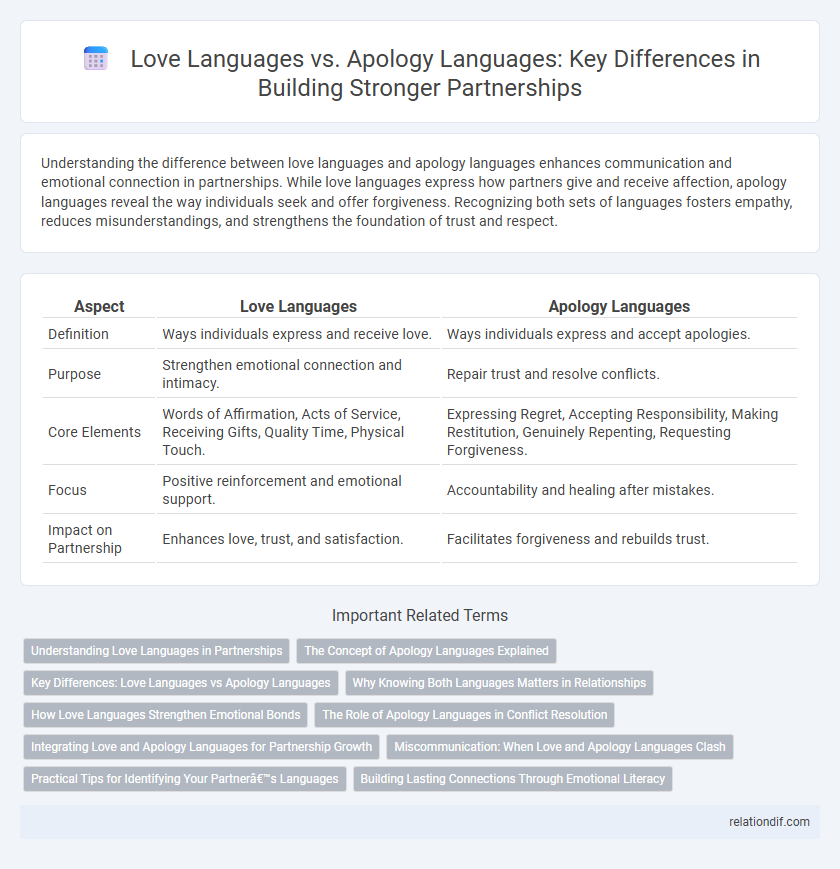Understanding the difference between love languages and apology languages enhances communication and emotional connection in partnerships. While love languages express how partners give and receive affection, apology languages reveal the way individuals seek and offer forgiveness. Recognizing both sets of languages fosters empathy, reduces misunderstandings, and strengthens the foundation of trust and respect.
Table of Comparison
| Aspect | Love Languages | Apology Languages |
|---|---|---|
| Definition | Ways individuals express and receive love. | Ways individuals express and accept apologies. |
| Purpose | Strengthen emotional connection and intimacy. | Repair trust and resolve conflicts. |
| Core Elements | Words of Affirmation, Acts of Service, Receiving Gifts, Quality Time, Physical Touch. | Expressing Regret, Accepting Responsibility, Making Restitution, Genuinely Repenting, Requesting Forgiveness. |
| Focus | Positive reinforcement and emotional support. | Accountability and healing after mistakes. |
| Impact on Partnership | Enhances love, trust, and satisfaction. | Facilitates forgiveness and rebuilds trust. |
Understanding Love Languages in Partnerships
Understanding love languages in partnerships enhances emotional connection by recognizing how each partner expresses and receives affection, such as through words of affirmation, acts of service, or physical touch. Misinterpreting love languages can lead to feelings of neglect, even when apologies are made, highlighting the need to also comprehend apology languages like expressing regret or making amends. Prioritizing both love and apology languages fosters empathy, strengthens communication, and deepens intimacy in long-term relationships.
The Concept of Apology Languages Explained
Apology languages describe the unique ways individuals express and receive apologies, enhancing understanding in partnerships by addressing emotional needs effectively. Unlike love languages that focus on expressions of affection, apology languages categorize five distinct modes: expressing regret, accepting responsibility, making restitution, genuinely repenting, and requesting forgiveness. Recognizing and responding to a partner's apology language can resolve conflicts more compassionately and strengthen relationship trust.
Key Differences: Love Languages vs Apology Languages
Love languages center on expressing and receiving affection through acts such as words of affirmation, quality time, physical touch, gifts, and acts of service, which strengthen emotional bonds. Apology languages focus on how individuals prefer to give and receive apologies, categorized into expressing regret, accepting responsibility, making restitution, genuinely repenting, and requesting forgiveness. Understanding these key differences enhances communication and conflict resolution in partnerships by tailoring expressions of love and apologies to each partner's preferred language.
Why Knowing Both Languages Matters in Relationships
Understanding both love languages and apology languages enhances emotional connection by addressing how partners express affection and seek forgiveness. Mastering these communication styles helps prevent misunderstandings and fosters deeper empathy, promoting healthier conflict resolution. Couples aware of each other's preferences experience increased trust and lasting intimacy.
How Love Languages Strengthen Emotional Bonds
Love languages, such as words of affirmation, acts of service, receiving gifts, quality time, and physical touch, strengthen emotional bonds by ensuring partners feel genuinely understood and valued. Identifying and expressing love through these languages fosters deeper connection and trust, essential for lasting intimacy. Integrating love languages into daily interactions enhances communication and reduces misunderstandings, leading to stronger partnership resilience.
The Role of Apology Languages in Conflict Resolution
Apology languages play a critical role in conflict resolution by addressing how individuals perceive and accept expressions of regret, which often differs from their preferred love languages. Understanding apology languages--such as expressing remorse, accepting responsibility, offering restitution, or seeking forgiveness--enables partners to communicate effectively and heal emotional wounds. Recognizing these distinctions fosters empathy and accelerates reconciliation, ultimately strengthening the partnership's emotional bond.
Integrating Love and Apology Languages for Partnership Growth
Integrating love languages and apology languages enhances emotional connection by addressing both expression of affection and conflict resolution in partnerships. Recognizing each partner's preferred love and apology languages fosters deeper empathy, reduces misunderstandings, and promotes healing after disagreements. This holistic approach to communication strengthens trust and supports sustainable relationship growth.
Miscommunication: When Love and Apology Languages Clash
Miscommunication often arises in partnerships when love languages and apology languages clash, causing partners to misinterpret each other's intentions and emotional expressions. Understanding that one partner's way of showing love may not align with the other's method of accepting apologies helps prevent resentment and fosters emotional clarity. Recognizing and respecting these distinct emotional languages enhances communication, strengthens trust, and deepens relational intimacy.
Practical Tips for Identifying Your Partner’s Languages
Identify your partner's love language by observing how they express affection, such as through acts of service, quality time, or physical touch, to tailor your gestures accordingly. Pay attention to their responses during conflicts to recognize their apology language, whether it involves words of affirmation, sincere gestures, or accepting responsibility. Use open-ended questions and reflective listening to clarify their preferences, ensuring your expressions of love and apologies resonate deeply and foster healthier communication.
Building Lasting Connections Through Emotional Literacy
Understanding Love Languages and Apology Languages enhances emotional literacy, fostering deeper empathy and connection in partnerships. Recognizing how partners express love and apologize helps prevent misunderstandings and strengthens trust. Mastery of these emotional communication tools builds a resilient foundation for lasting, meaningful relationships.
Love languages vs Apology languages Infographic

 relationdif.com
relationdif.com